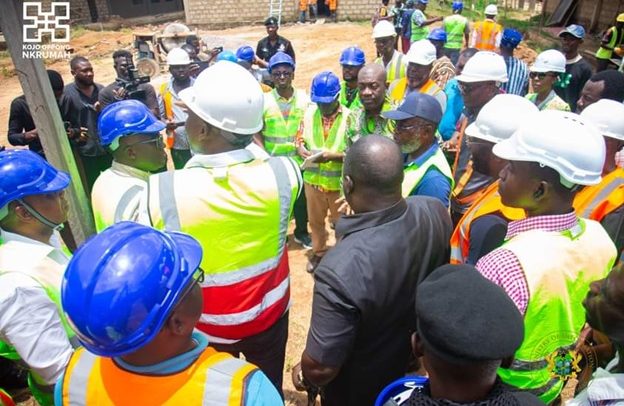The team at one of the sites
The government’s much touted priority health infrastructure project, Agenda 111 is poised to generate thousands of indirect jobs and employ a substantial healthcare workforce of 20,000 professionals.
Presidential Advisor on Health, Dr. Anthony Nsiah-Asare disclosed this at an Impact forum on the benefits of the Agenda 111 projects held in Kpassa in the Oti Region.
The event organized by the Office of the President in partnership with the Ministry of Information is the second in a series of many others aimed at updating Ghanaians on the progress of work on the government’s biggest health Agenda projects.
Dr. Nsiah-Asare highlighted the significant socioeconomic and employment opportunities that the initiative would bring.
“Agenda 111 is not just about constructing hospitals; it’s about creating opportunities and jobs for the people of Ghana. Through this project, we expect to employ approximately 20,000 health workers across various roles, from doctors and nurses to support staff,” he said.
“Additionally, the construction and operation of these hospitals will create thousands of indirect jobs, driving economic growth in the areas where these facilities are situated,” explained Dr. Nsiah-Asare.
The Agenda 111 project is an expansive initiative that includes the construction of 101 district hospitals in underserved regions, two psychiatric hospitals, seven regional hospitals, and the rehabilitation of the Accra Psychiatric Hospital.
Dr. Nsiah-Asare stressed that this undertaking aligns with the government’s vision to enhance healthcare infrastructure while boosting the nation’s economy.
Also present at the forum were the Information Minister, Kojo Oppong Nkrumah, Regional Minister, Joshua Gmayenaam.
Makubu, Project Consultant, Paul Osei, Traditional and Religious Heads, Officials of the Monitoring and Evaluation Secretariat at the Presidency as well as other well known dignitaries.
On his part, Mr. Oppong Nkrumah emphasized the meticulous planning and management of the project, which has been divided into eight zones, each comprising an average of 14 sites, each with dedicated teams of consultants, including architects, civil engineers, structural engineers, mechanical engineers, and biomedical engineers.
He stressed the importance of community engagement and collaboration to ensure the seamless integration and optimal functionality of the health facilities upon completion.
By Samuel Boadi


